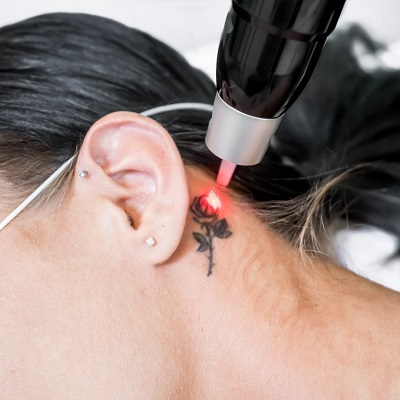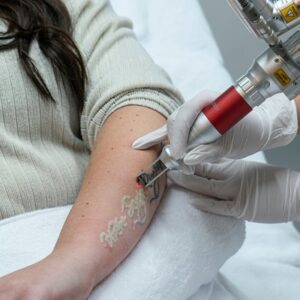
Many individuals remove or lighten tattoos they do not desire by laser tattoo removal. Moreover, it removes them effectively. However, many individuals are concerned about the probable negative effects, particularly scarring. Hence, Does Laser Tattoo Removal Cause Scars? This blog will discuss this in detail and how you can reduce the chance of negative consequences.
How Does Laser Tattoo Removal Work?
High-intensity light beams break the ink particles in them and remove them from the body. The body’s defense mechanism then absorbs these particles and gradually eliminates them. Since various colors absorb varying light durations, the kind of laser utilized depends on the color of the ink.
The procedure sometimes requires multiple treatments, separated by a few weeks or months. However, it depends on the size, color, and age. Moreover, certain tattoos are more difficult to remove, and the results you want might take more time to show.
Does Laser Tattoo Removal Cause Scars?
Does Laser Tattoo Removal Cause Scars depending on the scar itself and the type of laser? However, it sometimes leaves scars even though it is not probable. Still, with the correct care and expertise, this may be prevented. Most individuals who get this treatment follow the doctor’s advice and care guidelines, so most do not develop scars.
Not adequately tending to the region is the most common cause of bruising after this treatment. The skin is more prone to damage throughout the healing process; hence, scars might develop if you neglect to cover the region from becoming infected, irritable, or too much sun.
How to Minimize the Risk of Scarring?
To reduce the chances of scarring during this procedure, it is essential to follow several key guidelines:
Choose a Certified Professional:
The most crucial thing you can do to minimize scars is to select a trained, seasoned expert to handle the surgery. There are many degrees of laser expertise; if someone does not use the equipment correctly, you risks burning, boils, or other skin damage, leaving scars.
Follow Aftercare Guidelines:
After this therapy, your skin will be sensitive and can blister, swell, or turn red. Maintain hygiene to avoid infection and promote healing. Your surgeon or aesthetician will provide aftercare instructions; follow them properly.
Be Patient:
Getting rid of these permanent marks without leaving scars depends on your patience. Accelerating your skin by booking too many courses too quickly can harm it. Between treatments, allow your skin sufficient time to recuperate.
Avoid Scratching or Picking:
It is normal for the region to feel itchy or uncomfortable while the cut heals. Still, picking at the skin or itching could create scars. If you are in discomfort, use the lotions or ointments advised to soothe the region rather than aggravating it.
Protect skin from Sun:
Sunlight is among the worst things one could do for skin healing. After every session, the treated region gains increasing UV ray sensitivity. Direct touch could burn or alter skin’s color. Always cover or use a high-SPF sunscreen to shield your face from the sun.
Aftercare Instruction:
- Skin may appear red, swollen, and irritated for a few days post-treatment.
- Blisters are the immune system’s signal for healing.
- Recovery takes several weeks between sessions.
- Avoid scratching, picking at scabs, or leaving the area too wet during this period.
- These behaviors can impede healing and increase the risk of scar development or infection.
Some Skin Types are More Prone to Scarring:
Skin types with prior keloid scars might be more likely to develop scars again. Keloids are elevated scars resulting from excessively rapid skin healing. Before you begin the removal procedure, inform your practitioner about your inclination to develop keloid scars.
Darker skin tones may also be more prone to develop hyperpigmentation or hypopigmentation after the procedure; nonetheless, these issues often fade with time and care.
Final Thoughts:
Generally speaking, scars are not left if a certified professional performs it and the appropriate actions are performed after it. Though there is a little danger, seeing a qualified practitioner, following their advice after that, and allowing enough time for skin to recover between sessions can help to reduce it. For most individuals, it offers far more advantages than hazards; it may remove unwelcome tattoos without compromising the skin over time.
For more effective, scar-free laser tattoo removal, book your consultation with the certified expert at Dynamic Clinic PK.












